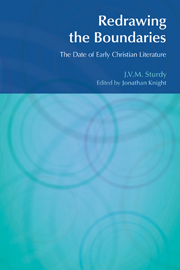Book contents
- Frontmatter
- Contents
- Preface
- Abbreviations
- 1 The Problem Posed
- 2 1 Clement
- 3 The Letters of Ignatius
- 4 Polycarp
- 5 Early Christian Literature: Some Parameters of Date
- 6 The Relationship of the Synoptic Gospels
- 7 Mark
- 8 Luke
- 9 Matthew
- 10 Acts
- 11 The Pauline Corpus: Its Growth and Development
- 12 The Catholic Epistles
- 13 Johannine Literature
- 14 Summary and Conclusions
- Appendix
- Notes
- Bibliography
- Index of Names
- Index of References
12 - The Catholic Epistles
- Frontmatter
- Contents
- Preface
- Abbreviations
- 1 The Problem Posed
- 2 1 Clement
- 3 The Letters of Ignatius
- 4 Polycarp
- 5 Early Christian Literature: Some Parameters of Date
- 6 The Relationship of the Synoptic Gospels
- 7 Mark
- 8 Luke
- 9 Matthew
- 10 Acts
- 11 The Pauline Corpus: Its Growth and Development
- 12 The Catholic Epistles
- 13 Johannine Literature
- 14 Summary and Conclusions
- Appendix
- Notes
- Bibliography
- Index of Names
- Index of References
Summary
In this chapter we will deal with the letters of the New Testament which are not attributed to Paul or John. This means that we shall consider 1 Peter, 2 Peter, James, Jude and Hebrews. I shall leave the Johannine writings until the next chapter.
Hebrews
Hebrews is a difficult piece of work which leaves us at first sight feeling lost. But there are at least some things that we can say quite clearly about it. Hebrews is not early. It seems to be sub-Pauline and was known to the author of 1 Clement. It is not Jewish-Christian in origin and seems definitely Gentile. It is very obviously third generation. This is revealed especially in the anxieties about falling away. The date to which I assign Hebrews is c.110 CE because it must be before 1 Clement.
It is odd that Hebrews contains no reference to the resurrection. But this is not the only oddity in Hebrews. Schenke shows that the picture of the cult is odd: it reflects neither the Old Testament nor contemporary Jewish ritual. This means that it must be based on a tradition that was interested in cultic matters.
The dependence on Paul is certain. Hebrews shows dependence on Romans and 1 Corinthians at least; possibly also 2 Corinthians, Galatians, 1 Thessalonians, just possibly Ephesians. There is also a relationship with the Apocalypse; in my view, it is likely that the author of the Apocalypse (c.150 CE) knew Hebrews.
- Type
- Chapter
- Information
- Redrawing the BoundariesThe Date of Early Christian Literature, pp. 72 - 74Publisher: Acumen PublishingPrint publication year: 2008

